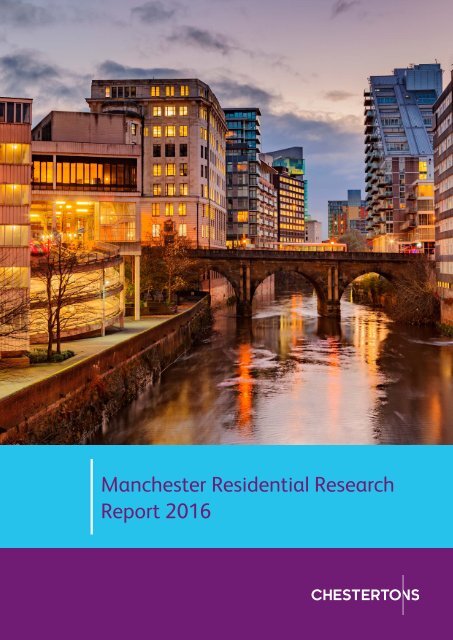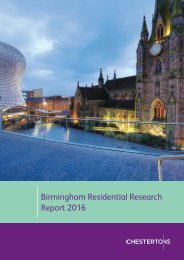Manchester Report
Create successful ePaper yourself
Turn your PDF publications into a flip-book with our unique Google optimized e-Paper software.
1<br />
<strong>Manchester</strong> Residential Research<br />
<strong>Report</strong> 2016
<strong>Manchester</strong> Residential Research<br />
<strong>Report</strong> 2016<br />
Introduction<br />
<strong>Manchester</strong> is the economic engine of the<br />
North West and the regional centre for finance,<br />
commerce, retail, culture and leisure. The economy<br />
has been growing at an average rate of just under<br />
3% per annum for the past decade and is forecast<br />
to accelerate over the next decade. More than<br />
140,000 people are currently employed within<br />
the city centre, a number which is projected to<br />
rise consistently over the next five years. The<br />
city is also a leading hub of the UK’s Northern<br />
Powerhouse agenda to promote growth and<br />
regeneration outside London and the South East.<br />
<strong>Manchester</strong>’s economic growth has been driven<br />
by the rapid expansion of a number of sectors<br />
including commercial and professional services,<br />
science and research, culture and media,<br />
advanced manufacturing and information and<br />
communications technology (ICT). It is now one<br />
of the top European cities for business location.<br />
It is also a centre of excellence for research and<br />
learning and boasts one of the largest student<br />
populations in Europe. It is home to several higher<br />
education institutions including the University<br />
of <strong>Manchester</strong>, the <strong>Manchester</strong> Metropolitan<br />
University (MMU), the Royal Northern College of<br />
Music, the Central <strong>Manchester</strong> University Hospitals<br />
and the University Hospital of South <strong>Manchester</strong>.<br />
The University of <strong>Manchester</strong> and <strong>Manchester</strong><br />
Metropolitan University alone have over 64,000<br />
students between them – around 12.5% of the<br />
city’s population.<br />
Connectivity<br />
The growth of the Greater <strong>Manchester</strong> area<br />
has been supported by significant investment in<br />
infrastructure. The £1.5bn Greater <strong>Manchester</strong><br />
Transport Fund (GMTF) has been in operation<br />
since 2009 while the Greater <strong>Manchester</strong><br />
Transport Strategy 2040 will guide future<br />
investment strategy.<br />
Among the major schemes is the expansion of<br />
<strong>Manchester</strong>’s city Metrolink tram system, which<br />
<strong>Manchester</strong> benefits from excellent transport<br />
links both nationally and internationally with<br />
<strong>Manchester</strong> Airport (the largest in England<br />
outside the south east) being the primary<br />
international gateway for the North of England.<br />
The city has undergone a remarkable<br />
transformation since the mid 1990s. Widespread<br />
regeneration and thoughtful urban design have<br />
created a distinctive contemporary city centre<br />
with high-quality new buildings and landscaping.<br />
The redevelopment of the city and the rising<br />
popularity of city-centre living has resulted in<br />
the population rising since the turn of the century,<br />
after having fallen to its lowest level in over 100<br />
years in 1999. The population of the city centre<br />
has trebled in the past decade to reach just under<br />
25,000, with this figure increasing to 50,000<br />
when the fringe areas are taken into account.<br />
The private rented sector has increased<br />
significantly in recent years and now represents<br />
around 20% of housing. Household projections<br />
and demographic trends from the council<br />
suggest that future demand for flats is likely<br />
to be considerable. The combination of strong<br />
tenant demand and attractive yields make the<br />
city a popular location for residential investors.<br />
The strong projected economic growth and rising<br />
population imply strong future capital and rental<br />
growth prospects for residential property.<br />
will have tripled in size when complete and already<br />
operates between the city centre and the airport.<br />
Looking further ahead, the city is expected to<br />
benefit greatly from the completion of HS2,<br />
which will cut the journey time to London from<br />
just over two hours to 68 minutes. Also planned is<br />
the £560 million Ordsall Chord scheme which link<br />
<strong>Manchester</strong> Victoria and <strong>Manchester</strong> Piccadilly<br />
stations and will significantly increase capacity<br />
at both stations.<br />
2
Just 20 minutes from the city centre, <strong>Manchester</strong><br />
Airport is the third largest in the country and<br />
handles more than 22 million passengers each<br />
year. Passenger capacity is expected to reach<br />
50 million per year by 2030 and heavy investment<br />
is planned to safeguard its future growth.<br />
<strong>Manchester</strong> City Council has recently approved<br />
plans to expand the Airport City Enterprise Zone<br />
and start work on a new 2.8 million square foot<br />
Life Sciences Enterprise Zone. The zones will act<br />
as a catalyst for new businesses.<br />
Economy<br />
Greater <strong>Manchester</strong> represents the largest<br />
functional economic area outside London,<br />
with a gross value added (GVA) of over £57 billion,<br />
equivalent to 3.5% of total UK GVA. The economy<br />
has been growing at an average rate of just<br />
under 3% per annum for the past decade.<br />
The Regional Centre (defined as <strong>Manchester</strong><br />
city centre and adjacent parts of Salford and<br />
Trafford) is the economic engine of the cityregion,<br />
employing around 160,000 people. It<br />
is a nationally significant centre for financial<br />
and professional services, knowledge-based<br />
creative and new media industries, cultural<br />
events, conferencing and retail. Rising numbers<br />
of national and international organisations<br />
are locating within the city centre, alongside<br />
increasing levels of new business start-ups.<br />
The Government is in the process of negotiating<br />
with the ten core cities (including <strong>Manchester</strong>) a<br />
series of tailored ‘city deals’ that will assist future<br />
growth. <strong>Manchester</strong> will become the fastest<br />
growing city outside of the south of England<br />
over the next three years, according to a report<br />
last year by Ernst Young. <strong>Manchester</strong>’s gross<br />
value added (GVA) is forecast to grow by 73%<br />
(averaging 3.7% pa) between 2014 and 2034,<br />
outpacing the projected wider regional growth<br />
over the period.<br />
Demographics<br />
Greater <strong>Manchester</strong> is the second most populous<br />
urban area in the UK and encompasses 2.7 million<br />
inhabitants in ten metropolitan boroughs: Bolton,<br />
Bury, Oldham, Rochdale, Stockport, Tameside,<br />
Trafford, Wigan, and the cities of <strong>Manchester</strong> and<br />
Salford. The City of <strong>Manchester</strong> accounts for just<br />
under a fifth (520,000) of the population. The<br />
population of the city centre has trebled in the<br />
<strong>Manchester</strong> is also investing heavily in digital<br />
connectivity and is the only city in the UK to<br />
offer next generation broadband with ‘fibre to<br />
the premises’, allowing speeds of up to 100mbps<br />
in a true open-access network. BT has recently<br />
completed a £575 million investment programme,<br />
which reportedly places <strong>Manchester</strong> ten years<br />
ahead of other UK cities in terms of access to<br />
digital communications.<br />
The Regional Centre will continue to be the focus<br />
for economic growth in Greater <strong>Manchester</strong>.<br />
Over 150,000 new jobs are forecast to be created<br />
in the Greater <strong>Manchester</strong> area over the next 20<br />
years, with 41% of these expected in <strong>Manchester</strong><br />
alone, a large proportion of which will be located<br />
in the Regional Centre. 70% of employment<br />
growth is forecast to occur in the highly productive<br />
commercial and professional services sectors.<br />
This will have positive implications for the<br />
housing market as these jobs will command<br />
higher salaries and thus improve household<br />
affordability prospects.<br />
Greater <strong>Manchester</strong> has a strong track record<br />
with regard to attracting inward investment,<br />
with 400 projects secured in the five-year period<br />
from 2010 to 2015, creating and safeguarding<br />
over 22,500 jobs. Recent investment includes<br />
Ferranti Computer Systems Ltd opening its first<br />
UK office for over 20 years at The Landing, a<br />
digital enterprise hub located within MediaCityUK,<br />
while international law firm Squire Patton Boggs<br />
has announced plans to set-up a 27,500sq ft<br />
office in the city centre and AFEX, a leading global<br />
payment firm, has announced it will be opening<br />
a new office located on Deansgate. Since 2011,<br />
the BBC has relocated around 2,700 staff into<br />
new premises at Media City.<br />
last decade to reach just under 25,000, with this<br />
figure increasing to 50,000 when the fringe areas<br />
are taken into account.<br />
<strong>Manchester</strong> has a relatively youthful population<br />
with just over half of the residents aged 30<br />
or younger and an average age of 33. The<br />
corresponding English averages are 38% and 39%.<br />
3
In contrast, only 13% of the city’s residents are<br />
older than 60, while the national average is just<br />
above 22%. Population projections from the<br />
Office for National Statistics (ONS) suggest that<br />
<strong>Manchester</strong>’s population will increase by around<br />
12% over the next 20 years, compared to a 10%<br />
rise in the Greater <strong>Manchester</strong> area.<br />
Greater <strong>Manchester</strong> has one of the largest<br />
student populations in Europe with over 105,000<br />
students across four universities: <strong>Manchester</strong><br />
University, <strong>Manchester</strong> Metropolitan University,<br />
the University of Salford, and the University of<br />
Bolton. In addition to the four universities in the<br />
city region there are a further 18 universities and<br />
higher education institutes in the North West,<br />
making for an additional population of around<br />
515,000 students in the surrounding areas. In the<br />
academic year 2014-15, <strong>Manchester</strong> University<br />
had the second highest number of foreign<br />
students (12,215) among UK higher education<br />
establishments.<br />
Planning<br />
<strong>Manchester</strong>’s Core Strategy was adopted in July<br />
2012 and is the key document in the <strong>Manchester</strong><br />
Local Plan. It sets out the long-term strategic<br />
policies for <strong>Manchester</strong>’s future development<br />
and covers the period from 2012 to 2027. The<br />
Regional Centre will be the focus for economic<br />
and commercial development, retail, leisure<br />
and cultural activity, alongside high-quality city<br />
housing. The growth of <strong>Manchester</strong> Airport will<br />
act as a catalyst for the regional economy, and<br />
will also provide the impetus for a second hub<br />
of economic activity in this part of the city.<br />
<strong>Manchester</strong> also forms part of the Government’s<br />
Northern Powerhouse initiative. Linked to this<br />
scheme, the Greater <strong>Manchester</strong> Devolution<br />
Deal will give new planning powers to local<br />
government in order to encourage regeneration<br />
and development, including a new £300 million<br />
fund for housing and greater control over local<br />
transport planning.<br />
<strong>Manchester</strong> city centre is defined as the area<br />
inside the Inner Relief Route and extends to the<br />
south to encompass the Oxford Road Corridor.<br />
The City Centre also includes Chapel Street,<br />
within the administrative boundary of Salford City<br />
Council, and the two city councils continue to work<br />
together to build a strong shared strategy for city<br />
centre regeneration. The City Centre Strategic<br />
Plan sets out a long-term vision for the future of<br />
the city centre, which will see the most intensive<br />
development of housing in <strong>Manchester</strong>. Key<br />
locations for residential development have been<br />
identified as Castlefield, Piccadilly, the Southern<br />
Gateway and the Northern Quarter.<br />
Residential Market<br />
Demand<br />
<strong>Manchester</strong> had a total of 217,240 homes<br />
according to the 2011 census. Owner occupation<br />
(37.8%) is way below the national average<br />
(63.3%), and the number of households renting<br />
privately (28.4%) well above the national average<br />
(16.8%). In addition to normal household<br />
demand, the large corporate and student<br />
sectors also make the city popular with investors.<br />
The University of <strong>Manchester</strong> and <strong>Manchester</strong><br />
Metropolitan University have more than 64,000<br />
students between them, with many living in the<br />
City, equating to 12.5% of the City’s population.<br />
Residential sales in <strong>Manchester</strong> have averaged<br />
just over 6,800 per annum over the past decade.<br />
As in the rest of the country, transaction numbers<br />
have not recovered to the levels seen in the preglobal<br />
recession peak but have improved steadily<br />
over the past three years. In 2015 a little over<br />
6,700 transactions were recorded, just over 50% of<br />
the 2006 peak of just over 13,000, though almost<br />
in line with the ten-year annual average.<br />
4
Figure 1: <strong>Manchester</strong> residential sales<br />
14,000<br />
12,000<br />
10,000<br />
8,000<br />
6,000<br />
4,000<br />
2,000<br />
0<br />
2006<br />
2007<br />
2008<br />
2009<br />
2010<br />
2011<br />
2012<br />
2013<br />
2014<br />
2015<br />
Source: Land Registry<br />
An increasing number of people are choosing<br />
to live in the regional centre, with the population<br />
rising from 7,000 in 2001 to 25,000 in 2016.<br />
This trend is set to continue, with around 50,000<br />
new homes anticipated to be needed by 2040.<br />
Household projections and demographic trends<br />
suggest that future demand for flats is likely to<br />
be considerable.<br />
The regional centre housing market is dominated<br />
by flats, sales of which have accounted for over<br />
95% of total sales over the past decade. Flat sales<br />
averaged 2,177 in the period 2006-15, which<br />
includes the years of market downturn following<br />
the global recession. The market has gathered<br />
momentum over the past three years with annual<br />
sales averaging 2,235.<br />
Figure 2: Residential sales v flat sales within <strong>Manchester</strong> regional centre<br />
6,000<br />
5,000<br />
4,000<br />
3,000<br />
2,000<br />
1,000<br />
0<br />
2006<br />
2007<br />
2008<br />
2009<br />
2010<br />
2011<br />
2012<br />
2013<br />
2014<br />
2015<br />
All sales<br />
Flat sales<br />
Source: Land Registry<br />
5
Supply<br />
The Local Plan has established that the city<br />
centre will be the focus of housing development<br />
in <strong>Manchester</strong> and it is expected that a minimum<br />
of 16,500 new homes will be delivered between<br />
2010 and 2027, equating to 917 homes per<br />
annum. However, the supply of new housing<br />
in recent years has been low for a city the size<br />
of <strong>Manchester</strong> and compared to pre-global<br />
recession years. Between 2009 and 2014, total<br />
housing stock only increased by 3%. While annual<br />
completions have averaged 1,674 over the past<br />
decade, in the last three years the average drops<br />
to less than half of this number. This suggests that<br />
supply may struggle to keep pace with anticipated<br />
future demand.<br />
Figure 3: <strong>Manchester</strong> residential completions<br />
3,500<br />
3,000<br />
2,500<br />
2,000<br />
1,500<br />
1,000<br />
500<br />
0<br />
2006/07<br />
2007/08<br />
2008/09<br />
2009/10<br />
2010/11<br />
2011/12<br />
2012/13<br />
2013/14<br />
2014/15<br />
2015/16<br />
Total<br />
Private<br />
Source: DCLG<br />
Note: 2015/16 only includes data for the first three quarters<br />
Prices<br />
Values have recovered much of the lost ground<br />
following the global recession fallout but are still<br />
12% below the ten-year market peak. Annual price<br />
growth to March 2016 was 7.4% according to the<br />
Land Registry, ahead of the North West regional<br />
average (+5.3%) and the national average of 6.7%.<br />
Figure 4: <strong>Manchester</strong> average residential sold prices: 2006-15<br />
£120,000<br />
£115,000<br />
£110,000<br />
£105,000<br />
£100,000<br />
£95,000<br />
£90,000<br />
£85,000<br />
£80,000<br />
2006<br />
2007<br />
2008<br />
2009<br />
2010<br />
2011<br />
2012<br />
2013<br />
2014<br />
2015<br />
Source: Land Registry<br />
6
Yields<br />
Current gross initial yields are higher than in many<br />
other large cities in the country, and considerably<br />
better than those on offer in London. Rental growth<br />
prospects are also strong, given the projected<br />
growth in household numbers and the likelihood<br />
that supply will not keep pace with demand.<br />
Figure 5: Gross initial yields: 1-bed flats<br />
Central London 3.7%<br />
Bristol City Centre<br />
Cardiff City Centre<br />
4.5%<br />
4.7%<br />
Newcastle City Centre<br />
Birmingham City Centre<br />
Sheffield City Centre<br />
Leeds City Centre<br />
<strong>Manchester</strong> City Centre<br />
5.7%<br />
5.9%<br />
6.0%<br />
6.3%<br />
6.7%<br />
0.0% 1.0% 2.0% 3.0% 4.0% 5.0% 6.0% 7.0%<br />
Source: Zoopla & Chestertons Research<br />
Figure 6: Gross initial yields: 2-bed flats<br />
Central London 3.2%<br />
Bristol City Centre<br />
4.3%<br />
Birmingham City Centre<br />
Liverpool City Centre<br />
5.5%<br />
5.9%<br />
Leeds City Centre<br />
Sheffield City Centre<br />
<strong>Manchester</strong> City Centre<br />
6.4%<br />
6.5%<br />
6.5%<br />
0.0% 1.0% 2.0% 3.0% 4.0% 5.0% 6.0% 7.0%<br />
Source: Zoopla & Chestertons Research<br />
7
Our Services<br />
Chestertons provides a range of services to home owners,<br />
London, Chestertons has one of the largest networks in<br />
the capital, as well as a strong international presence.<br />
Our services include<br />
– Sales: We will manage the entire sales process, from giving an accurate and<br />
accepted.<br />
– Lettings: Our highly qualified teams ensure we find the best quality tenants<br />
and achieve the best possible rents and terms, protecting landlords’ investment<br />
and their tenants’ well-being through our professional customer service and<br />
stringent compliance processes.<br />
– Property management<br />
tenants and rent collection, through to full management of individual properties<br />
and portfolios.<br />
– Leasehold services: We specialise in helping clients with the valuation and<br />
negotiation process involved in lease extensions, freehold purchases and<br />
collective enfranchisement.<br />
– Mortgage finance: We specialise in arranging finance for properties at<br />
the mid to top end of the market through our partner Springtide Capital.<br />
Contact<br />
Amit Seth<br />
Head of International Residential<br />
Developments - UAE<br />
T: +971 50 885 0961<br />
E: amit.seth@chestertons.com<br />
Mohamad Ibrahim<br />
Head of International Residential<br />
Development -KSA<br />
T: +966 50 103 5777<br />
E:mohamad.ibrahim@chestertons.com<br />
Reproduction of this document in whole or in part is not permitted without the prior written approval of Chestertons. April 2016.<br />
8















